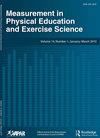Validation of Garmin and Polar Devices for Continuous Heart Rate Monitoring During Common Training Movements in Tactical Populations
IF 1.9
4区 教育学
Q2 EDUCATION & EDUCATIONAL RESEARCH
Measurement in Physical Education and Exercise Science
Pub Date : 2022-12-28
DOI:10.1080/1091367X.2022.2161820
引用次数: 0
Abstract
ABSTRACT Heart rate samples (n = 4500–8000) from wearables were compared to electrocardiography during a steady-state ruck (Ruck-S), maximal effort ruck (Ruck-M), submaximal cycle (Cycle), and Tabata Circuit. One device was worn at each location (wrist: Polar Grit-X, Garmin Fenix 6; chest-straps: Polar H10, Garmin HRM-Pro; armband: Polar Verity). Comparisons were made via percent error (MAPE) ≤5%, Concordance Correlation Coefficient (CCC), and ordinary least product regressions (OLP). H10 demonstrated strong agreement for all movements (MAPE = 1.28–3.40%, CCC = 0.93–0.99). During Ruck-S, Ruck-M, and Cycle, HRM-Pro (MAPE = 1.96–3.73%, CCC = 0.95–0.99) and Verity (MAPE = 1.84–5.36%, CCC = 0.98–0.99) demonstrated strong agreement. Fenix-6 demonstrated low MAPE (4.23–5.44%) and moderate to strong CCC (0.76–0.96) for Ruck-S, Ruck-M, and Cycle, while Grit-X had poor agreement (MAPE = 8.49–16.45%; CCC = 0.24–0.78). Tabata Circuit had the worst disagreement for all devices. Overall, chest straps and armbands demonstrated the strongest agreement, and should be worn when precise heart rate training is necessary.Garmin和Polar装置在战术人群常见训练动作中用于连续心率监测的验证
摘要心率样本(n = 4500–8000)与稳态ruck(ruck-S)、最大努力ruck(ruck-M)、次最大循环(cycle)和Tabata Circuit期间的心电图进行比较。每个位置都佩戴一个设备(手腕:Polar Grit-X,Garmin Fenix 6;胸带:Polar H10,Garmin HRM Pro;臂章:Polar Verity)。通过百分比误差(MAPE)≤5%、协调相关系数(CCC)和普通最小乘积回归(OLP)进行比较。H10对所有运动表现出强烈的一致性(MAPE = 1.28–3.40%,CCC = 0.93–0.99)。在Ruck-S、Ruck-M和周期期间,HRM Pro(MAPE = 1.96–3.73%,CCC = 0.95–0.99)和Verity(MAPE = 1.84–5.36%,CCC = 0.98–0.99)显示出强烈的一致性。Fenix-6对Ruck-S、Ruck-M和Cycle表现出较低的MAPE(4.23–5.44%)和中等至强烈的CCC(0.76–0.96),而Grit-X的一致性较差(MAPE = 8.49–16.45%;CCC = 0.24–0.78)。Tabata Circuit在所有设备中的分歧最为严重。总的来说,胸带和臂章表现出了最强烈的一致性,当需要精确的心率训练时应该佩戴。
本文章由计算机程序翻译,如有差异,请以英文原文为准。
求助全文
约1分钟内获得全文
求助全文
来源期刊

Measurement in Physical Education and Exercise Science
Medicine-Orthopedics and Sports Medicine
CiteScore
4.20
自引率
33.30%
发文量
24
期刊介绍:
The scope of Measurement in Physical Education and Exercise Science (MPEES) covers original measurement research, special issues, and tutorials within six substantive disciplines of physical education and exercise science. Six of the seven sections of MPEES define the substantive disciplines within the purview of the original research to be published in the journal: Exercise Science, Physical Activity, Physical Education Pedagogy, Psychology, Research Methodology and Statistics, and Sport Management and Administration. The seventh section of MPEES, Tutorial and Teacher’s Toolbox, serves to provide an outlet for review and/or didactic manuscripts to be published in the journal. Special issues provide an avenue for a coherent set of manuscripts (e.g., four to five) to collectively focus in-depth on an important and timely measurement-related issue within the scope of MPEES. The primary aim of MPEES is to publish high-impact manuscripts, most of which will focus on original research, that fit within the scope of the journal.
 求助内容:
求助内容: 应助结果提醒方式:
应助结果提醒方式:


